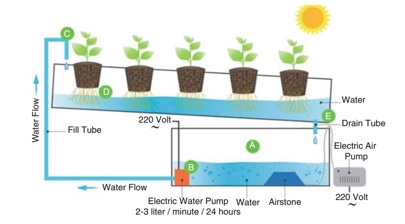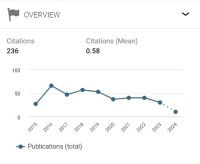Smart Vertical Farming: The Role of IoT in Achieving Sustainability and Resource Efficiency
Abstract
The rapid growth of population and ongoing urbanization have posed significant challenges to global food production systems. With more than half of the world's population now residing in urban areas, this figure is projected to rise to 70% in the coming decades. The conversion of agricultural land into residential and infrastructure zones has reduced local food production capacity, increasing reliance on food supplies from outside urban areas. Additionally, climate change exacerbates these challenges through weather fluctuations that affect agricultural yields in rural regions. Vertical farming has emerged as an innovative solution, offering an environmentally friendly approach to meet the growing food demand. Vertical farming systems enable the year-round production of high-quality crops with fully automated environmental controls powered by Internet of Things (IoT) technologies. Using sensors and artificial intelligence, vertical farming can monitor and adjust growth factors such as temperature, humidity, and lighting in real time. This study aims to explore the contributions of smart vertical farming in achieving sustainability and resource efficiency by analyzing resource utilization, environmental sustainability, and economic and social impacts. The research seeks to provide insights into the potential of vertical farming as a scalable, self-sustaining mechanism to support urban food security. The findings are expected to contribute significantly to the development of more environmentally friendly and sustainable agricultural practices in the future.
Downloads
References
[2] Halgamuge, M. N., Bojovschi, A., Fisher, P. M., Le, T. C., Adeloju, S., & Murphy, S. (2021). Internet of Things and autonomous control for vertical cultivation walls towards smart food growing: A review. Urban Forestry & Urban Greening, 61, 127094.
[3] Arabzadeh, V., Miettinen, P., Kotilainen, T., Herranen, P., Karakoc, A., Kummu, M., & Rautkari, L. (2023). Urban vertical farming with a large wind power share and optimised electricity costs. Applied Energy, 331, 120416.
[4] National Geographic. (n.d.). Feeding 9 billion. Retrieved from https://www.nationalgeographic.com/foodfeatures/feeding-9-billion.
[5] Adedibu, Peter Adeolu. "Ecological problems of agriculture: impacts and sustainable solutions." ScienceOpen preprints (2023).
[6] Efendi, R., & Sagita, D. (2022). Teknologi pertanian masa depan dan peranannya dalam menunjang ketahanan pangan. Sultra Journal of Mechanical Engineering, 1(1), 1-12.
[7] Raj, P., Maurya, P. K., Darjee, S., & Rout, S. (2023). Sustainable Farmer-Friendly Technologies for Soil Management. ADVANCED FARMING TECHNOLOGY, 34.
[8] Barui, P., Ghosh, P., & Debangshi, U. (2022). Vertical farming-an overview. Plant Archives (09725210), 22(2).
[9] Tooy, Dedie, et al. "Towards Global Food Security: Vertical Farming as an Innovative Solution." J Intern. of Futures Studies 6.3 (2023): 335-347.
[10] Qaiser, M. Z., Roshan, R., Raj, K., Alam, N., & Rizvi, Z. K. (2024). Vertical Farming: Exploring the Potential of The Future.
[11] Mir, M. S., Naikoo, N. B., Kanth, R. H., Bahar, F. A., Bhat, M. A., Nazir, A., ... & Ahngar, T. A. (2022). Vertical farming: The future of agriculture: A review. The Pharma Innovation Journal, 11(2), 1175-1195.
[12] Lagiman, L. (2021). Pertanian Berkelanjutan: Untuk Kedaulatan Pangan Dan Kesejahteraan Petani.
[13] Tooy, Dedie, et al. "Towards Global Food Security: Vertical Farming as an Innovative Solution." J Intern. of Futures Studies 6.3 (2023): 335-347.
[14] Kaiser, Elias, et al. "Vertical farming goes dynamic: optimizing resource use efficiency, product quality, and energy costs." Frontiers in Science 2 (2024): 1411259.
[15] Pomoni, D. I., Koukou, M. K., Vrachopoulos, M. G., & Vasiliadis, L. (2023). A Review of Hydroponics and Conventional Agriculture Based on Energy and Water Consumption, Environmental Impact, and Land Use. Energies, 16(4), 1690. https://doi.org/10.3390/en16041690.
[16] Naskali, A. T., Pinarer, O., & Tolga, A. C. (2022). Vertical farming: under climate change effect. Environment and climate-smart food production, 259-284.
[17] Ezzahoui, I., Abdelouahid, R. A., Taji, K., & Marzak, A. (2021). Hydroponic and Aquaponic Farming: Comparative Study Based on Internet of things IoT technologies. Procedia Computer Science, 191, 499-504.
[18] Fasciolo, B., Awouda, A., Bruno, G., & Lombardi, F. (2023). A smart aeroponic system for sustainable indoor farming. Procedia CIRP, 116, 636-641.
[19] Van Gerrewey, T., Boon, N., & Geelen, D. (2021). Vertical farming: The only way is up?. Agronomy, 12(1), 2.[26]
[20] Gurung, Lalendra & Rawal, Janak & Joshi, Ganesh & Rc, Puspa & Mandal, Ashmita. (2024). Vertical Farming in Urban Agriculture: Opportunities, Challenges, and Future Directions. 10.26480/bda.02.2024.89.95.
[21] Zhou, Y. (2024). Technological Innovation and Significance of Vertical Farming System in High-Density Urban Areas. In E3S Web of Conferences (Vol. 579, p. 03001). EDP Sciences.
[22] Shao, Y., Li, J., Zhou, Z., Hu, Z., Zhang, F., Cui, Y., & Chen, H. (2021). The effects of vertical farming on indoor carbon dioxide concentration and fresh air energy consumption in office buildings. Building and Environment, 195, 107766.
[23] Hossain, A., Sarkar, S., Rahman, M. A., Bhatt, R., Garai, S., Saha, S., ... & Meena, R. S. (2021). Ecological intensification for sustainable agriculture in South Asia. Ecological Intensification of Natural Resources for Sustainable Agriculture, 171-213.
[24] Kumar, R., Singh, M., & Gupta, A. (2021). IoT Applications in Smart Agriculture: A Review. Journal of Agricultural Technology, 17(5), 89-104.
[25] Chen, L., Zhao, X., & Li, Y. (2022). IoT-Driven Vertical Farming for Sustainable Urban Agriculture. Sustainable Agriculture Journal, 12(3), 56-67.
[26] Ali, M., Ahmed, S., & Zaman, T. (2023). Enhancing Vertical Farming through IoT and AI Integration: A Sustainable Approach. Journal of Smart Agriculture Systems, 8(2), 45-59.
[27] Rathor, A. S., Choudhury, S., Sharma, A., Nautiyal, P., & Shah, G. (2024). Empowering vertical farming through IoT and AI-Driven technologies: A comprehensive review. Heliyon.
[28] Ibrahim, L. A., Shaghaleh, H., El-Kassar, G. M., Abu-Hashim, M., Elsadek, E. A., & Alhaj Hamoud, Y. A. (2023). A Sustainable Path to Food Sovereignty and Enhanced Water Use Efficiency. Water 2023, 15, 4310.
[29] Nesheli, S. A., & Salaj, A. T. (2024). Urban farming for social benefit. IFAC-PapersOnLine, 58(3), 351-356.
[30] Shrivastava, A., Nayak, C. K., Dilip, R., Samal, S. R., Rout, S., & Ashfaque, S. M. (2023). Automatic robotic system design and development for vertical hydroponic farming using IoT and big data analysis. Materials Today: Proceedings, 80, 3546-3553.
[31] Yadav, S., & Swamy, V. (2022). IOT based Vertical Farming using PH calibration and controlling. In Proceedings of the International Conference on Innovative Computing & Communication (ICICC).
[32] Dadheech, P., Kumar, A., Singh, V., Raja, L., & Poonia, R. C. (2021). A neural network-based approach for pest detection and control in modern agriculture using internet of things. In Smart agricultural services using deep learning, big data, and IoT (pp. 1-31). IGI Global.
[33] Kour, K., Gupta, D., Gupta, K., Dhiman, G., Juneja, S., Viriyasitavat, W., Mohafez, H., & Islam, M. A. (2022). Smart-Hydroponic-Based Framework for Saffron Cultivation: A Precision Smart Agriculture Perspective. Sustainability, 14(3), 1120.
[34] Ng, H. T., Tham, Z. K., Rahim, N. A. A., Rohim, A. W., Looi, W. W., & Ahmad, N. S. (2023). IoT-enabled system for monitoring and controlling vertical farming operations. International Journal of Reconfigurable and Embedded Systems, 12(3), 453.
[35] Naranjani, B., Najafianashrafi, Z., Pascual, C., Agulto, I., & Chuang, P. Y. A. (2022). Computational analysis of the environment in an indoor vertical farming system. International Journal of Heat and Mass Transfer, 186, 122460.
[36] Kabir, M. S. N., Reza, M. N., Chowdhury, M., Ali, M., Samsuzzaman, Ali, M. R., Lee, K. Y., & Chung, S.-O. (2023). Technological Trends and Engineering Issues on Vertical Farms: A Review. Horticulturae, 9(11), 1229.
[37] Ghazal, S., Munir, A., & Qureshi, W. S. (2024). Computer vision in smart agriculture and precision farming: Techniques and applications. Artificial Intelligence in Agriculture.
[38] Kim, J., Park, H., Seo, C., Kim, H., Choi, G., Kim, M., Kim, B., & Lee, W. (2024). Sustainable and Inflatable Aeroponics Smart Farm System for Water Efficiency and High-Value Crop Production. Applied Sciences, 14(11), 4931.
[39] Dwikiarta, I. M. S., Sastra, N. P., & Wiharta, D. M. (2021). Kinerja jaringan sensor nirkabel untuk model smart building. Majalah Ilmiah Teknologi Elektro, 20(2), 211.
[40] Wiradani, P. A. P., Jasa, L., & Rahardjo, P. (2022). Analisis Perbandingan Produktivitas Material Budidaya Akuaponik Berbasis IoT (Internet of Things) dengan Budidaya Akuaponik Konvensional. Majalah Ilmiah Teknologi Elektro, 21(2), 263.
[41] Chowdhury, M., Islam, M.N., Reza, M.N. et al. Sensor-Based Nutrient Recirculation for Aeroponic Lettuce Cultivation. J. Biosyst. Eng. 46, 81–92 (2021).
[42] Akateva, L. V., Kalinin, V. A., Ivanov, V. K., Ivanov, A. V., & Kholkin, A. I. (2022). Development of an automated vertical farm module for growing plants using additive technology. Theoretical Foundations of Chemical Engineering, 56(4), 618-625.
[43] Wei, Z., & Fang, W. (2024). UV-NDVI for real-time crop health monitoring in vertical farms. Smart Agricultural Technology, 8, 100462


This work is licensed under a Creative Commons Attribution-NonCommercial-NoDerivatives 4.0 International License.

This work is licensed under a Creative Commons Attribution 4.0 International License




